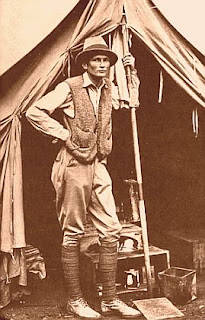| One of the first views of Macchu Picchu after the fog cleared |
Macchu Picchu is a Pre-Columbian structure built in
the 15th Century. Although there are many theories surrounding the
exact purpose of this imposing structure, most scholars agree that it had an
important religious purpose. And the location which was strategically chosen
was virtually untakeable.
 |
| Hiram Bingham |
And here for some gossip : In 1911, the American
researcher Hiram Bingham from the university of Yale claimed to have “discovered” the Lost City of the
Incas” as he called Macchu Picchu. But he later acknowledged that the site not
only was known to the locals but that even other citizens of the outside world
had visited the it prior to him.
Nevertheless credit must be given to Bingham for the thorough scientific approach he had in mapping, surveying, cleaning and numbering and booking every building and artifact he found on the site. He is indeed the one who brought Macchu Picchu to the attention of the world.
More gossip: The Peruvian government agreed to Bingham sending thousands of pieces of
artifacts to Yale University with the understanding that these pieces would be
returned within two years. One century later most of these may still be admired
in the Peabody Museum at Yale !
As we were approaching the 100 years celebrations of
the “re-discovery” of Macchu Picchu by Hiram Bingham, the Peruvian Govt filed a
lawsuit against Yale University to have the pieces retuned to Peru. In early
2010 Yale University accepted to return most of the pieces under certain
conditions.
| A side view of the huge complex of buildings surrounding a sacred rock |
The Government of Peru has not been without reproach
either in the management of the site. They used it as the cash cow in terms of
tourist spending. In the year 2003 an overwhelming 400.000 tourists visited
this site. Poor maintenance, unlimited number of tourists and permission to
build a cable car for easier access and a heliport right in the middle of the site have led to
some tremendous uprising from the scholars, scientists, the general
international public and most
importantly the people of Peru. UNESCO classified this site as endangered in
the 1980’s. All this (plus of course financial pressure) forced the Peruvian Govt
to review its management of the site.
It must be said though that this site it still very
expensive to access. The train (operated by Americans) costs over US$100 for as
many kilometres, the small shuttle charges US$12 for a 20 minutes ride which
are about 10 times the going rates for similar distances.
Some of the first things the Govt of Peru did were the
cancelations of permits for helicopter flights over the site (it is now a
no-fly zone) as well as for the construction of the cable car and other
commercial projects including building shopping stalls around the site.
They limited the number of visitors to 4000 per day to
Macchu Picchu and 400 per day to Huayna Picchu from where one has a spectacular
view of the ruins. In July 2011 they reduced the per diem quota to 2500.
We were in Ecuador when we learned about the new
regulations and we decided to promptly book our tickets to Macchu Picchu online.
And of course we opted for the Huayna Picchu as well, in the first 200 to climb at 7am (the other
half climbs at 10am).
On the eve, we got to Aguas Calientes which is an ugly
town whose sole reason to be is to house the tourists before their trip to the
sacred Inca city. Anyway we still tried our luck at the natural thermal baths
(Aquas Clientes literally means Hot Waters). But on seeing the two little pools
filled with people and the water that had already turned brown we decided we would
pass our turn !
The next morning we wake up at 4.30am to prepare jam sandwiches. We then make sure
that by 5.15am we’re in line waiting for the first shuttles to bring us up to
the gates of Macchu Picchu. We get there just before the gates open at 6am.
| At 6am and we cannot see the buildings that surround us |
When we get in all the preparation and anticipation
make way for … FOG ! We can’t see anything because it is so thick. We literally
don’t even know in which direction the ruins are. Freelance guides offering
their services point us in the right direction and finally we start discerning
the contours of the buildings.
| Macchu Picchu is in front of us but we can't see it |
| It's clearing up |
| Macchu Picchu as seen from Huayna Picchu |
After hundreds of pictures, we are happy to make our way down back to Macchu Picchu where we join a guided group. The tour lasts for two hours and we are given explanations of the ins and outs of the functioning of the city.
| The classic "postcard" angle |
At about 1pm we take the shuttle back down to Aguas
Calientes an d board the train back to Cusco…Mission accomplished!
Full set of pictures of Macchu Picchu
Full set of pictures of Macchu Picchu
No comments:
Post a Comment